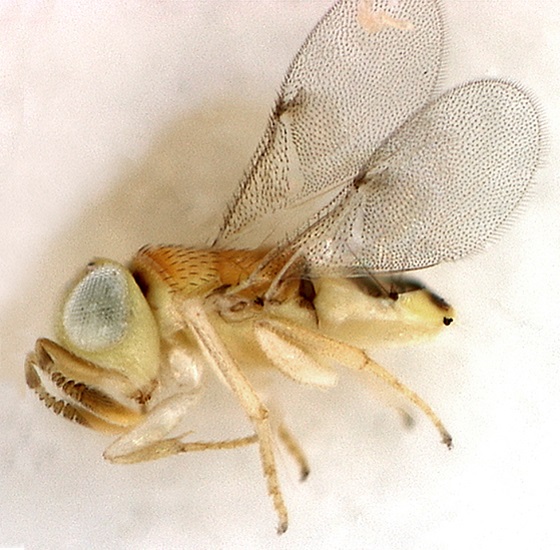
A new CABI-led study has shown the potential distribution of a natural enemy that is being used to fight the devastating papaya mealybug pest across East Africa.
The scientists, who published their findings in the journal Biological Control, used a predictive correlative model to explore the potential distribution of Acerophagus papayae – a parasitic wasp which has proved to be a successful biocontrol agent for the papaya mealybug (Paracoccus marginatus) in a number of countries in Africa.
Papaya mealybug is a highly polyphagous invasive pest that affects at least 133 economically important crops and causes economic losses worldwide. For example, in Kenya alone, it is estimated that the value of the crop losses is around £2,224/ha each year.
Pest is serious threat to papaya growing counties
The pest, which originated from Central America before spreading to the Caribbean and South America in the 1990s, was first detected in Mombasa County, Kenya, in 2016 and poses a serious threat to all 10 of the country’s papaya growing counties including Meru, Murang’a, Kitui, Busia and Baringo.
The scientists found that areas that were highly suitable for P. marginatus and were also suitable for A. papayae were highest across West Africa. Whilst there were areas which were suitable for both species in both East Africa and Central Africa, there were large areas of cropping land which were highly suitable for P. marginatus although not suitable for A. papayae.
Across Northern and Southern Africa, there were limited cropping areas which were suitable for P. marginatus and where there was suitability, it was only moderate. Across these areas, there was limited suitability for A. papayae.

The results offer timely information on the potential environmental suitability of A. papayae across Africa with the aim to help guide decisions on the areas where use of A. papayae could be used effectively as a part of an integrated pest management programme against P. marginatus.
Good suitability for A. papayae across South Sudan and southern Somalia
The scientists suggest that whilst populations of P. marginatus have not been officially recorded in some areas of Eastern and Southern Africa, areas of high suitability for P. marginatus extend to the south coast of Somalia, to non-coastal areas of Tanzania, to central and southern Mozambique and to Uganda, and South Sudan. Of these areas, the results suggest good suitability for A. papayae across South Sudan and southern Somalia.
They add that there is no or limited suitability of the parasitoid in the other areas, suggesting that if P. marginatus were to invade, other control methods, besides release of A. papayae, would have to be explored. Small experimental releases in low to no suitability areas, however, would help to validate these assumptions.
Dr Ivan Rwomushana, a co-author of the research, said, “Whilst results from our study can give an indication of areas which may be suitable for A. papayae, it is important to note that environmental suitability is not the only factor affecting the survival of populations of A. papayae and their utility as a biocontrol agent. One major factor is the population density of the host species.
“This is specifically important for A. papayae as there are no other known host mealybugs for this parasitoid, so populations would be completely dependent on P. marginatus, and thus areas where the population density of P. marginatus is low might be less suitable for release of A. papayae as a biocontrol agent, even if environmental conditions are favourable.”
Various factors affect effectiveness of A. papayae at controlling populations of P. marginatus
The scientists also say that even if A. papayae were able to become established in an area, there are other factors which would affect how effective it would be at controlling populations of P. marginatus.
The plant hosts of P. marginatus, for example, have been shown to significantly affect various life metrics of A. papayae; A. papayae individuals lived the longest, had more offspring in general, as well as more female offspring when they were able to parasitise P. marginatus which had fed on papaya.
Step up the fight against the papaya mealybug
In July CABI and partners agreed to step up the fight against the papaya mealybug on more farms in Kenya to help protect livelihoods and food security.
Scientists from CABI’s regional centre for Africa in Nairobi, Kenya, deployed A. papayae in the counties of Machakos, Makueni, Embu, Tharaka Nithi and Baringo, where the pest affects smallholder farmers and causes significant losses.
This means CABI scientists and colleagues from the Kenya Agricultural and Livestock Research Organisation (KALRO), the Kenya Plant Health Inspectorate Service (KEPHIS) and the National Museums of Kenya (NMK) are now fighting the pest – which can destroy whole crops – in total of eight counties across the country. The fight has also been extended to Uganda and South Sudan.
The work was funded by the CABI-led PlantwisePlus programme, with additional funding from the Darwin Initiative project ‘Biocontrol of papaya mealybug in East Africa’, which looks at the impacts of this classical biological control strategy on native insect biodiversity.
Additional information
Main image: A papaya tree infested with papaya mealybut at Baringo County (Credit: CABI).
Full paper reference
Elizabeth A. Finch, Kris A.G. Wyckhuys, Ivan Rwomushana, Potential distribution of Acerophagus papayae, a parasitoid of the papaya mealybug (Paracoccus arginatus), across Africa, Biological Control, Volume 198, 2024. DOI: 10.1016/j.biocontrol.2024.105628.
The paper can be read open access here.
Relevant stories
‘Parasitic wasps play pivotal role in Kenya’s papaya mealybug control.’
‘CABI and partners step up fight against devastating papaya mealybug on more farms in Kenya.’
Related News & Blogs
South Sudan smallholder farmers embrace nature’s solution to papaya mealybug menace
Smallholder farmers in South Sudan are embracing nature’s solution to the papaya mealybug menace which has been devastating crops since it first invaded East Africa between 2015 to 2020. The papaya mealybug (Paracoccus marginatus) causes up to 91%…
12 August 2024


